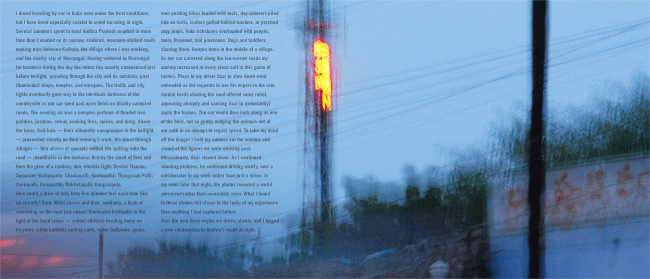The Road at Night: Andhra
In 2009 and 2010 I directed the Village India Program for Washington University in Kalleda, Andhra Pradesh. Kalleda is a tiny village of about 1200 people and several hundred more buffaloes, and the point of our being there was to bring students from Wash U to teach enrichment classes in a high school run by the Rural Development Fund. The program took place in July, which is, typically, monsoon, but because of the erratic conditions of climate change, some years the monsoon never comes and the area remains in drought. In 2009 we were in drought. In 2010 it rained and was quite comfortable.
The nearest town of any size is Warrangal, about 45 minutes by car from Kalleda. Warrangal had many of the amenities of a small, Indian city, and in 2010 I had a small project that required me to go to Warrangal regularly. I hated those trips. Traveling by car anywhere in India is a nightmare, even under the best conditions. The road between Kalleda and Warrangal was narrow, curvy, potholed, and the darkest dark one can imagine, and because I was typically traveling to Warrangal late in the afternoon after our teaching was concluded I was forced to return to Kalleda as night was wrapping the countryside in a blanket of blackness. That area of Andhra Pradesh is primarily rice paddy or grazing of livestock, so at night the road is filled with people and animals— buffaloes, bullocks, goats—returning home from the fields. And there are school kids on bikes and on foot, and smaller children playing on the side of the road.
Our driver, Azar, for that month of the program, drove with a reckless abandon that gave me stomach aches every trip. He didn’t like to use the headlamps because they wouldn’t last as long. And he didn’t use his wipers either, same reason. But he liked to drive fast, despite my pleas to slow down. Sometimes he couldn’t avoid driving slowly because of the congestion of animals on the road, and on one of those occasions I put my camera out of the window and took a bunch of random shots. Azar slowed down when he saw me taking pictures. It didn’t take me long to realize that if I kept shooting he’d keep driving slowly. But that night when I reviewed the pictures I’d shot from the moving car I saw something in them that I felt captured the essence of India better than any of my carefully composed pictures shot under better conditions. It felt, to me, like I could almost smell the heady mix in the air of jasmine, mud, animal dung, cooking fires, and sweat, the perfume of rural India. I went out with Azar for three more nights, driving slowly and making photographs, in a beautiful partnership.
Because I see the world through the lens of the book and the two-page landscape of the page, this body of pictures came alive for me when they were placed in the sequence of the book, forming a narrative of my journey from Warrangal into the nighttime landscape of Kalleda.
The book measures 8.5 x 9.25 inches, printed digitally on Moab Entrada paper, 190 gsm, there are 34 pages bound as a “modified” accordion with dry adhesive. The case is stamped with the title in a dark gray starch-filled linen, with spine in red cloth. 25 numbered copies, $1400.





